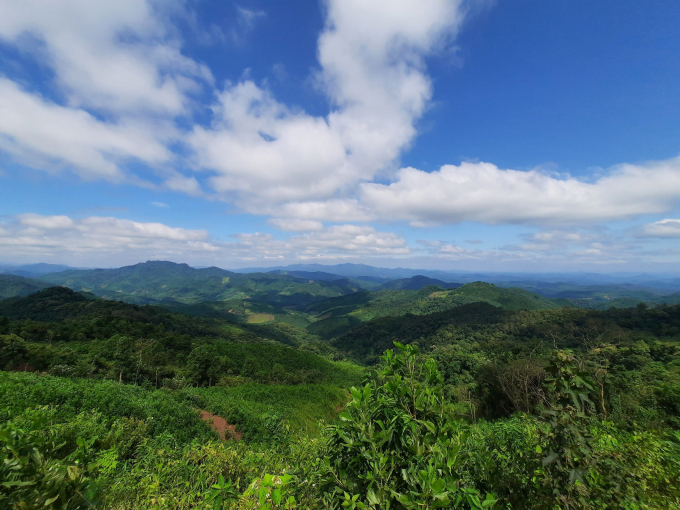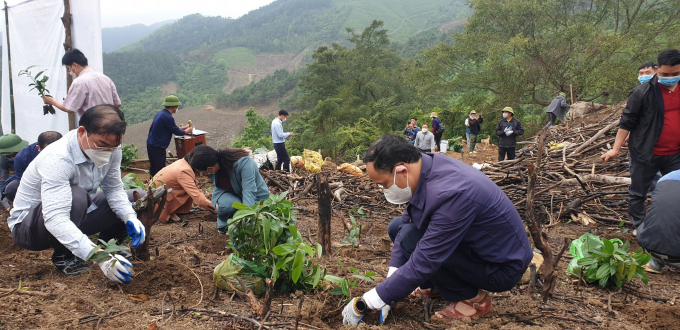May 29, 2025 | 16:15 GMT +7
May 29, 2025 | 16:15 GMT +7
Hotline: 0913.378.918
May 29, 2025 | 16:15 GMT +7
Hotline: 0913.378.918

People of Ba Che have a stable income from growing medicinal plants under forest canopy. Photo: Nguyen Thanh
Quang Ninh has an area of land planned for forestry of 435,932 ha, accounting for more than 70% of the province's natural area in which 370,144 ha is covered in forest, ranking 18th out of 63 provinces and cities in Vietnam.
Resolution No. 19-NQ/TU (dated November 28, 2019) of the Standing Committee of the Provincial Party Committee on “Sustainable forestry development in Quang Ninh to 2025 - vision to 2030”, after implementing for two years, has opened a new direction in effectively protecting and exploiting forest resources. This helps Quang Ninh make great progress in the rapid and sustainable development of the province’s forestry industry.
Quang Ninh is preparing a scheme to establish Dong Rui - Tien Yen wetland conservation area – an area of international importance (Ramsar sites) and a scheme to closely protect the Syzygium gratum forest, primeval choi forest in Co To district, and jambolan forest in Van Don district. Up to now, the planned area for special-use forests has also been raised to over 47,000 ha - an increase of 22,000 ha compared to before the issuance of Resolution 19.
Localities with protection forests and key water reservoirs such as Van Don, Tien Yen, Hoanh Bo, Cam Pha, and Dong Trieu all focus on planting additional protection forests in order to promote the role of watershed protection of large rivers.

Vast green forests in Quang Ninh. Photo: Nguyen Thanh.
Developing a sustainable forest management plan has become a mandatory requirement for forest-related units. Afforestation is always in line with the establishment and management of protection forests and special-use forests within the protection corridor for new water sources, with priority given to large reservoirs.
Starting from having only one sustainable forest management plan, up to now, 12/17 units under the approval of the People's Committee of Quang Ninh province have completed the construction and approved the course of actions for sustainable forest management with a total area of 97,024 ha.
Taking full advantage of topographical advantages, localities in Quang Ninh province have mobilized people to renew seedlings and plant trees with high economic value. People have actively invested in seedlings, fertilizers, and labor to improve the productivity and quality of planted forests.
To be more specific, in order to meet the market’s demands, people in localities have gradually shifted from planting small timber forests to planting large timber forests. Reality has shown that in the same area the large timber plantation cycle brings approximately 2.5-3 times higher profits than the continuous implementation of two small timber business cycles.

People actively participate in afforestation activities. Photo: Cuong Vu.
Implementing the plan of the provincial People's Committee to plant 2,500 ha of new large timber forests, by the end of July 2022 the whole province has planted over 1,600 ha, including 391.5 ha of Erythrophleum fordii, 853.5ha of Magnolia hypolampra, 398.9 ha of Chukrasia tabularis and an area mixed with all three types of 8.8 ha.
“Upon participating in the large timber plantation model, association members and farmers will be given support one time in terms of seedlings according to their needs and receive guidance and training on techniques and learn from practical experience by visiting effective large timber plantation models in other localities in the province,” Vice Chairman of Quang Ninh Farmers' Association Le Van Do said.
Localities give priority to the development of raw material areas in service of the wood processing as well as paper and artificial board production industries. Up to now, The province has a growing area of pine resin with a total area of more than 18,000 ha at present, concentrated in Uong Bi, Dong Trieu, Van Don, Ba Che, and Mong Cai; a non-timber forest plantation of Indian mulberry, anise, sasanqua camellia, cinnamon and other medicinal plants with an area of more than 9,500 ha, concentrated in Ha Long, Ba Che, Binh Lieu, Dam Ha, and Hai Ha.
Quang Ninh has set a target that there will be 5,000 ha of ironwood forest in the province by 2025; the rate of laborers working in forestry with vocational training reaches 45%; 50% of households in mountainous areas and ethnic minorities living in forested areas participate in commodity forestry; approximately 60,000 - 70,000 people have jobs with an average income of VND 6 million/month.
Translated by Samuel Pham

(VAN) FAO’s Director-General addresses the 5th Baghdad International Water Conference.
/2025/05/26/1716-4-nongnghiep-191706.jpg)
(VAN) Chain linkages, technological innovation, and raw material zoning are three strategic pillars for the coconut industry to strongly develop and elevate its position on the global agricultural map.
![Advanced mariculture – an inevitable trend: [4] Accompanied by scientists](https://t.ex-cdn.com/nongnghiepmoitruong.vn/608w/files/sohk/2025/05/13/1941-pgsts-vo-van-nha-140958_717.jpg)
(VAN) According to Assoc. Prof. Dr. Vo Van Nha, Director of the RIA III, the development of advanced offshore mariculture is no longer an option but an essential path for Vietnam’s fisheries sector.

(VAN) Vietnam is intensifying the development of mollusk farming areas that meet international standards, aiming for sustainable growth and enhancing its export position in the global seafood market.
![Advanced mariculture – an inevitable trend: [3] Policy-driven momentum](https://t.ex-cdn.com/nongnghiepmoitruong.vn/608w/files/doanhtq/2025/05/21/0104-0616-0348-nuoi-bien-170339_789.jpg)
(VAN) To ensure the success of offshore mariculture that uses advanced technologies, it is essential to establish supportive policies that inspire both individuals and enterprises to invest with confidence.
![Advanced mariculture – an inevitable trend: [2] Outstanding results](https://t.ex-cdn.com/nongnghiepmoitruong.vn/608w/files/sohk/2025/05/12/4632-4136-nuoi-bien-11-164117_819.jpg)
(VAN) Pilot models of high-tech offshore mariculture in Vietnam, particularly in the South Central Coast region, have demonstrated exceptional economic returns and sustainability, setting a new direction for the country’s aquaculture industry.
![Advanced mariculture – an inevitable trend: [1] Moving offshore](https://t.ex-cdn.com/nongnghiepmoitruong.vn/608w/files/phucpm/2025/05/18/0252-2436-nuoi-bien-6-162148_783.jpg)
(VAN) Mariculture using advanced technology and moving offshore is an inevitable trend, as nearshore areas increasingly reveal limitations.